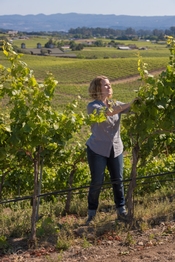How often do you get to taste bottles of finished wines which are available to consumers that feature individual clones from a single vineyard?
A few weeks ago, that was the invitation I received – a Zoom session being held by Bouchaine Vineyards to try three bottles of Carneros-grown clones of Pinot Noir and one Pinot blend of various clones. And to make the  event even more interesting, the tasting would be led by the very talented Chris Kajani, who for the past eight vintages has been winemaker at Bouchaine after taking over when Michael Richmond retired.
event even more interesting, the tasting would be led by the very talented Chris Kajani, who for the past eight vintages has been winemaker at Bouchaine after taking over when Michael Richmond retired.
Of course, nobody is more fascinated by the myriad clones of Pinot Noir than California winemakers. And, as a writer and wine lover, I am fascinated by their fascination.
Why are they so intrigued? Partly, I think, it’s a matter of history. Back in the 1970s, Napa Valley Cabernet Sauvignon winemakers seemed to quickly achieve parity with Bordeaux without having to steal cuttings from Lafite, Haut Brion or Margaux, or even reflect much at all about where their vines came from, what rootstocks they used or how they pruned and trellised their vines. They simply made Cabernets that in short order received reviews and prices that only Bordeaux had previously commanded. Many critics even began using Napa as a reference point as to what properly ripened Cabs should taste like.
Naturally, Pinot Noir planters said, “Why not us?” Even transplants adopted this West Coast can-do mentality in their quest to make Pinot Noirs that were the equal of those from Burgundy. It might take a little longer, they reasoned, maybe even five or six vintages. It was a matter of just finding the right terroir. So, they tried beside the bay, in the mountains, along the coast. Nice wines, but not Burgundy. Then they turned to clones. They didn’t work either, although some fabulous wines were being made.
So, wisely, most gave up on trying to be Burgundy. (Okay, maybe it could still be done if they could convince Aubert de Villaine to snip cuttings of his Romanée-Conti vines, hide them in his suitcase and personally plant then un-grafted when he flew back to his second home in the Carneros – no, probably not going to happen.) Instead, they decided to make California Pinot Noirs which could be pretty damn good in their own right.
Nevertheless, they retained their fascination with how Pinot Noir clones love to, well, clone. Plant those suckers in a vineyard, and 10 years later they would adapt and change accordingly. (Does your Joseph Swan look like my Joseph Swan?)
But I digress.
For the tasting, Kajani first pulled out her plot map of the 104-acre estate and its 97 acres of planted vines draped like a green quilt across the rolling bayside terrain. Listed on it were 12 Pinot Noir clones, some Dijon variants, as well as Swan, Pommard. Mt. Eden and Calera.
The first selection tasted was the 2019 Bouchaine “Swan Clone” Napa Valley Pinot Noir ($65). My abbreviated, jot-‘em-down notes were “very lean and very crisp – the most Burgundy-like of the three” to distinguish it from the others. As Kajani tasted, she said “nice structure, nice tension on the palate,” adding, “It was the last block picked, a late-ripener with bigger berries.”
Next was the 2019 Bouchaine “Pommard Clone” Napa Valley Pinot Noir ($65). Having tasted earlier, my notes were “fragrant and smooth, juicy, slightly fruity sweet.” Kajani said, “The Pommard has thick skins, so there’s a snap to the tannins even if the wine is creamy. I used more oak on this one, and I tell people this is the Pinot Noir for Cabernet lovers.” She took another sniff. “Another thing – as Pommard ages, it takes on a definite mocha flavor.”
The 2019 Bouchaine “Dijon Clone” Napa Valley Pinot Noir ($65) was the final of the three. My differentiating notes were “spicier, leaner, more tannins.” Kijani noted that it was the darkest of the clones and the first harvested. “This one is planted on volcanic soil,” Kajani says. “It has dark cheery flavors, but with a tea rose, spicy, floral note. There are a lot of tannins present.”
All were delicious. Of the three, I found the Dijon to be my favorite, although, like many dedicated drinkers, the wine I choose often has more to do with my mood and the occasion.
Some wineries like to make their blends to be the most-impressive and highest-priced, but the 2019 Bouchaine Napa Valley Pinot Noir ($40) – the estate wine – seems to be intended to be more of an accessible, entry-level starter Pinot leading to the others selections. My notes were, “not as fragrant, some savory hints, long on the palate – a versatile food wine.” Kajani said, “This was less about the oak and more about the balance – something to enjoy right now,” selected from about 20-some vineyard blocks. “Making it was like crazy Jenga – what to leave it, what to leave out,” she summed up. Or like a Bob Seeger lyric.
Finally, Kajani said, focusing on year and not just the clones, “I call 2019 the ‘Goldilocks’ vintage,” she says. “Not too cold, not too hot, but just right.” And “just right” might just describe Kijani’s approach to Pinot Noirs clones as well.
68
